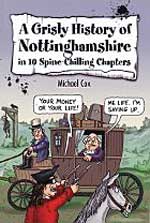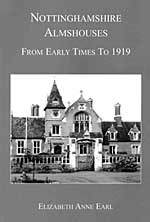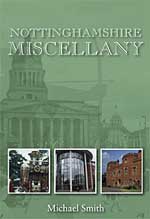Book reviews, Spring 2012
A grisly history of Nottinghamshire in 10 spine-chilling chapters
Michael Cox. 2011, Nottinghamshire County Council. £5.95. ISBN 987-0-902751-72-9

Michael Cox is a local children’s author who addresses a variety of historical events that happened throughout Nottinghamshire’s past. However, what makes this book different to other historical books is that it looks at things that people are less likely to have known about. For example, the tale of Robin Hood is known in several parts of the world, let alone just Nottingham, although events such as the River Trent once running red due to all the fighting in the 15th century is less known and may not be known. Likewise about the Great Cheese Riot in 1764 as a response to overpriced dairy products.
The layout of the book is split into ten chapters, making it easy to read and therefore appealing to a younger audience. The activities of guessing correct answers and true and false questions also show its intention for children and allows them to engage in their own learning. Although it being intended for children, and it having a chapter specifically including ‘nice things’ for those that may not like the more gruesome parts of Nottingham’s history, words throughout the book such as ‘grisly’ and ‘pongy’, and the pretend splatters of blood on the pages show that this children’s book is most likely intended for boys, and those who enjoy reading about gruesome events. The jokes make the seriousness of any events light-hearted and enjoyable to read, such as a man trying to sell his wife.
The fact that Cox is looking at local history is important as it shows that there is an interest in educating people about the history of where they are from. Overall I would recommend this book to anyone wanting to find out about Nottinghamshire’s history, as although the way it is written and the illustrations show that it is a children’s book, I see no reason why adults couldn’t also enjoy the book as well as learn from it!
Charlotte Butler. (Ed: Charlotte is a first year history student at Teesside University)
Nottinghamshire almshouses from early times to 1919
Elizabeth Ann Earl, 2011. Self-published. ISBN 978-0-9532092-1-7

This is a soft-back book of 78 pages with many black & white illustrations and a couple of maps to locate sites in the county and city.
The book is more of a gazetteer than a detailed history of each almshouse covered. Each entry gives some salient points but the author explains in her Foreword that, out of the many references that she noted during her research, she has used a couple at random in the entries ‘for the purpose of succinctness’.
What I find strange is the comment that some almshouses have been omitted; why? This devalues the book and, at least, a list of ones not detailed could have been provided and would be most useful to readers and other researchers.
There is an index but it only lists the names of the almshouses covered and so is of restricted value. The author lists references for each entry and provides a bibliography.
Given the reservations mentioned and the feeling that the book is intended for a general rather than a more local history minded reader, it is a useful book and is recommended to anyone with an interest in almshouses in the county.
Nottinghamshire miscellany
Michael Smith. 2011. The Derby Books Publishing Co. Ltd. ISBN 978-185983-817-4 £12.99.

A hardback book of 288 pages with some black & white illustrations and nicely printed on quality paper.
The author, Michael Smith retired as Vice-Principal of Castle Donington Community College in 2005. He holds a BA(Hons) degree from the Open University, an MA from the University of Nottingham and a Local History qualification from Keele University. He has worked as a WEA lecturer and has also lectured for the University of Nottingham and has written seven books.
This is not a book to read from cover to cover but one to dip into because each page has several facts about the county. Although there is no index (one listing at least place and person names would have been very useful) there are 34 chapter headings making it a relatively easy task to locate an item on a particular subject. The cover blurb describes the book as ‘A guide book, a history book, a gazetteer, a sporting compendium, a dictionary of biography and a fund of factoids for the quiz fanatic’; to a greater or lesser degree it is all of these.
The book starts with a chapter ‘Introducing Nottinghamshire’ which lists various facts about the modern county and it then moves on to a section on history and ends with a section called ‘This and That’ where items that don’t fit elsewhere are included. Some of the items will date quickly, particularly those relating to politics but, nevertheless, these listing are a useful reminder of the position as at 2010.
A great deal of research has gone into this volume and the result is an interesting book, full of facts and figures which will delight the reader. My only real criticism, and it applies to many local history books, is the quality of the illustrations; in this book they are overly dark resulting in a loss of much detail which is a great shame.
Nevertheless, this is a book which is recommended to anyone with an interest in our county.
Howard Fisher